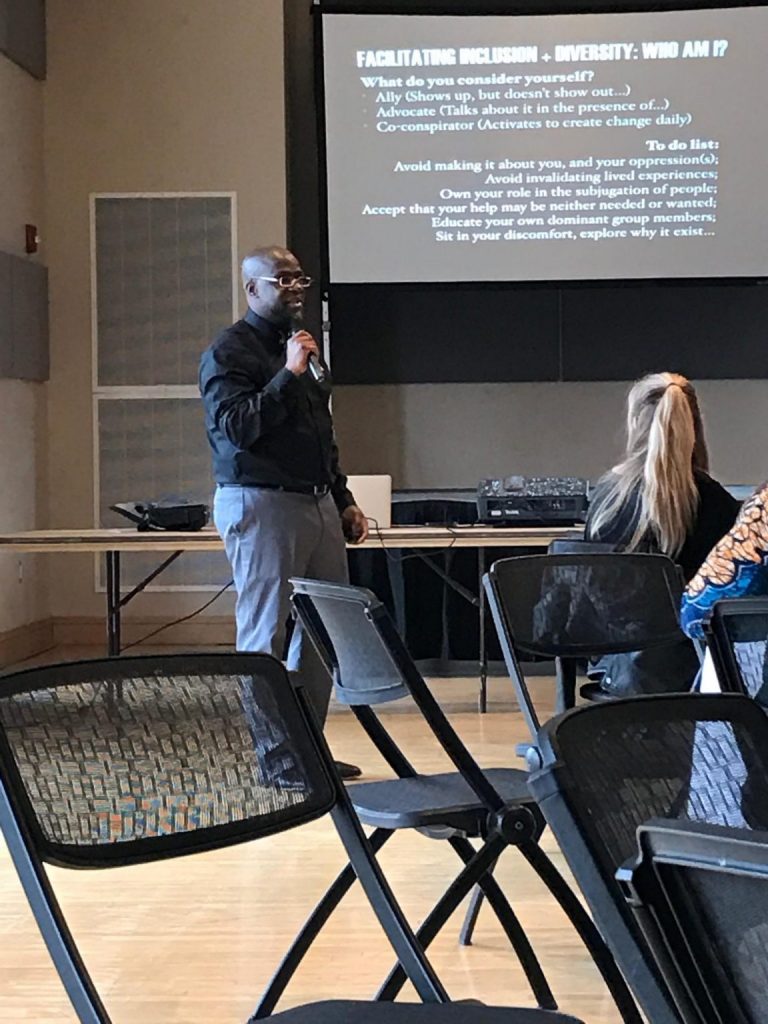How does diversity look

How does diversity look and whose perspective should be heard first were some of the questions asked by an assistant professor of educational psychology and leadership at Texas Tech University at the third annual Diversity Conference hosted by USU Eastern Feb. 17.
In the keynote address by Bryan Hotchkins, Ph.D., who describes himself as one of the intellectual voices in the country and co-founder of Think Positionality (2013), he told students, staff, faculty and community members to ask themselves six questions.
How does diversity look, whose perspective should be heard first, what is your vision for diversity on campus, how do you tell stories about diversity and what does your diversity look and sound like?
In discussing his definition of diversity, Hotchkins used math equations to navigate cultural differences. “Diversity, plus inclusion, equals belongingness.”
His identity-based K-20 trainings and programs about race, gender and leadership teach that diversity is “constantly in a state of danger; one must appreciate informed white students who care; and practice patience, erase ignorance and not again.”
“How does one measure resilience, critical thinking, self actualization and community to social justice and diverse under-oppressed student populations in meaningful ways that are encouraged, communicated and associated as collegiate-excellence outcomes,” he asked.
Discussing critical race magnets, he said, include leadership, advocacy, scholarships, community, involvement and culture. “Students must ask themselves how are they going to fit in while the university must ask itself what can it do to make it easier for students to fit in with identity and inclusion?”
Which identities makes people the least and most comfortable, he said, include bias persona, racist, homophobic, misogyny and transgender were named as some of the common identities shared by the audience. “We all have biases . . . we must gravitate towards or away from those that stray away from belongingness.”
Group pathology examples explained words describing the public perception of classes of people. Hotchkins’ examples included the word illegal to define Latinos, terrorism for Muslims, thugs for blacks, athletes for Pacific Islanders and psychopaths for whites.” These are totally unacceptable descriptions, he said.
After reading USU Eastern’s mission statement, he said he really liked it because it talked about diversity and culture. “We have to ask ourselves which identity is most welcome and which is best supported? The university must help students navigate campus and locate inclusive spaces.
Hotchkins said, “International identity is really a math equation. What differentiates us from others? Diversity is measured by numerics: black, plus male, plus nerd, equals an academic anomaly.
“Patriarch, plus misogyny, plus limited institutional access, equals sexism.
“Power, plus privilege, plus unfettered institutional advancement, equal racism.”
The university and each student are responsible to raise awareness of inclusion, diversity and awareness, he concluded.
Eight workshops highlighted the diversity and inclusion conference including “Post Election Climate & Concerns;” Why We Do What We Do: The Six Human Needs;” “Valuing the Differences;” “Social, Political and Mental Health Obstacles Within the LGBTS+ Community;” “How to Be an Ally;” Unmasking Microaggressions;” “College Success: Self-Care for Marginalized Students;” and “Interrogating D(I)versity of Identity.”




